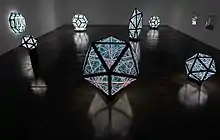Anthony James (artist)
Anthony James is a British/American artist based in Los Angeles, known for his monumental and experiential sculptures and installations. His work gestures towards the theatricality of minimalism and formalism. There is a focus on materiality, alchemy, and a deep respect for light and space.
"My work is my best attempt at giving the impossible, the infinite, a physical, objective existence. The materials are merely an extension of the gesture. I start with the gesture and have spent decades distilling these concepts down to the essential. So whether I’m using vanguard, illustrious materials and high technology or centuries old metal techniques — my interest is in communicating the most direct way I can. There is a minimalistic simplicity to the work, yet it expresses something infinite — it’s a pluralistic paradox. I’ve tried to visually demonstrate the colossally vast and the infinitesimally small — the cosmos and the divinity inside oneself." [1] Aesthetica Magazine
Anthony James | |
|---|---|
 Anthony James in his Los Angeles studio, 2020 | |
| Born | December 1974 England |
| Nationality | British/American |
| Occupation | British/American artist |
| Known for | Sculpture, painting, and experiential installations. |
Notable work | Portals, KΘ (Kalos Thanatos), Birch |
Early life and education
Anthony James was born in England in 1974. He studied in London at Central Saint Martins College of Art and Design and graduated with a degree in fine art painting.
"being a child in the 70s and 80s in England — there was a lot of chaos. you know how mother nature self corrects – adapts – heals? maybe I was drawn to formalism and minimalistic art because in many ways it is inverted chaos. maybe it’s my way of creating order." [2] Designboom
James has also called New York City, Munich, and Los Angeles home. Currently, he is based in Los Angeles and operates his studio in Downtown LA.
Art
"My job as an artist is to make my work look effortless, but of course it’s not. The human eye only hits the mistakes. I will never let your eye hit on a mistake.” [3]
Portals / Platonic Solids / Archimedean Solids, 2008-present
Anthony James started with the Icosahedron - a shape that represents water. Water shifts, moves, flows ... it rages — relaxes. With remarkable flexibility it is gas, liquid, solid...visible to invisible in moments. Surely, water must be the conduit of the Aquarian world.
"I’m interested in revealing and sharing truth. My intention is to bring an impossible concept like the idea of infinity, or the cosmos, into physical objective existence. I am attempting to express science, spirituality, and philosophy in an object the purest and most honest way I know how."
The sculptures, made of stainless steel, glass, and LED lights, have shown internationally to great acclaim.
Repose, 2020
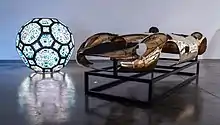
The series consists of three Ferrari bodies: the 1957 250TR, 1962 250 GTO, and the 1967 P4. The sculptures are presented in archival quality bronze, aluminum, and copper. In their original incarnations, each of these Ferrari’s are exemplary automotive specimens -- the apex of power, form, function, and aesthetics. Yet, here they are memorialized in performative stillness – monumental memories of their own pasts.
KΘ Kalos Thanatos, 2008

James gained international recognition in 2008 for his work Kalos Thanatos (KΘ), Greek for “beautiful death”, when he burned his Ferrari F335 Spyder in a birch forest, and then displayed it in a mirrored glass box with birch tree trunks. James was inspired by the ancient Greeks, who made sacrifices to Aphrodite in birch forests.[4] Glenn O’Brien lauded James’ Kalos Thanatos by describing it as daring: “I miss art going out on a limb...Just a slim limb that looks like there’s at least some chance of it snapping...Anthony James burned his Ferrari and put it in a box, amid, actually, a bunch of limbs. That was going for it….this work is pretty gutsy...The car was a victim, a sacrifice old-school redux.”[5]
"you can’t really escape yourself. you’re always on the same thing. the artwork may present differently, but there is always an underlying signature theme. for me, everything is life / death / birth / rebirth somehow. it’s not an intention, but it all comes back to one source. burning a ferrari and stuff — it’s all instinctual. now I look back at it and ‘beautiful death’ is more of a concept than a sentence. it’s bizarre. you can’t escape your own destiny which is what the iliad is about." [6] Designboom
The Birch Series, 2005-Present
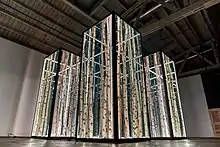
James originally debuted The Birch Series in New York City in 2005. It consisted of several variously sized, vertical light boxes with young birch tree trunks inside. The sculpture series references the containment and simulation of nature. The works have mirrored sides, which give the illusion of an endless birch forest. The pieces are composed of birch trees, metal, glass, and fluorescent lights or LEDs. The birch tree is associated with magical symbolism. Glenn O’Brien wrote about birch trees that their “magic...is rooted in [the] special relationship with fly agaric mushrooms - that famed toadstool of the red cap and white spots - which is so often associated with elves and spirits...Many anthropologists consider it to be a possible agent of the transformation of human consciousness.”[7]
Of the series, James said, "I think about the containment of nature. The containment of our own nature. There’s something about the individuals journey that is really at the root of it. Going into the forest — not knowing what you’ll find — not knowing if you’ll ever return... You can see the metaphor." "They resemble a contradiction between like a Stanley Kubrick and Gustav Klimt. It’s Gustav Klimt mourning the way they’re lit, it’s this endless birch forest, but everything is in too much symmetry. You know, there’s something menacing there. What first appears to be beautiful is actually quite menacing in a Kubrick way." [8]Interview
Bullet Series, 2011-Present

“I first started making the Bullet Series in 2011. They are documented in my book, Morphic Fields, published by Hatje Cantz Verlag in 2014. The concept behind the series was to make a visual demonstration of the universe.
The material used is mirror polished steel. I wanted to puncture the steel with an effortless gesture and flow in a similar attempt to how Lucio Fontana would slice his canvas with a knife or puncture paper with a pencil. Given the nature of steel, a knife and a pencil were not a possibility.
I took an arsenal of assault rifles, shotguns, pistols, revolvers...you get the idea. The gesture became a meditation - almost a Zen practice. I am particularly fond of these works...and they’re a lot of fun to make.”
Anthony James’ Bullet Series builds upon his signature themes of life, death, birth, and rebirth. James’ career has consistently gestured toward bringing impossible concepts — like the idea of infinity, or the cosmos...science, spirituality, and philosophy — into physical, objective existence often utilizing vanguard high technology alongside industrial materials. With the Bullet Series, James once again invites viewers to experience the pieces as an external object upon which to gaze and an invitation to reflect inward upon the divinity within one’s Self. The mirror polished steel nods toward California’s finish fetish artists of the 1960s and 1970s. Paradoxically, James punctures the fantasy with an assortment of arms creating dissonance — a pluralistic paradox reminiscent of the chaotic Big Bang. Simultaneously, the flawless polished steel belies its truth — there was no preordained plan...one thing is destroyed — another created.
Morphic Fields, 2014

Morphic Fields was an exhibition of bronze and limestone pieces inspired by the scientist Rupert Sheldrake’s theory of morphic resonance: “a process whereby self-organizing systems inherit a memory from previous similar systems.”[9] Sheldrake describes his theory relative to the artistic process: “Every morphic fields starts with some creative step. Newton was the first person to think of the law of gravity. And before he’d thought of it, no one else had. Since then, millions of people have been able to think of it. So all morphic fields begin with individuals…Very few contemporary artists have the sense of inspiration from a transcendent source beyond the human realm. But I would argue that they are also drawing from the collective human experience. As much as there is room for individual creativity, every artist is also transcending collective memory. Artists can create new morphic fields. Yet, all art exists within a morphic field beyond the individual.”[10] The sculptures are created from found materials and “through [James’] process of converting...waste into bronze they morph into something very beautiful and precious.”[11]
Shields, 2015-Present
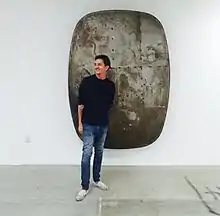
Shields was an exhibition of curved disks made of brass, bronze, and steel “scarred with minimalist markings.” This series “operates elusively, staggering between the iconic and the arbitrary, the concrete and the alchemic, the mythical and experiential.”[12] James describes his work as, “evoking pictorial depictions of the cosmos, alluding to notions of mysticism, ethereality, and science fiction, all the while anchored through the use of weighty, industrial materials such as metal."[13] The shields “read as relics or artifacts from some liminal moment, as such, James attempts to locate beauty in the wake of insanity.”[14]
Rain Paintings, 2018

A photorealistic series made of contradictory materials: Belgian linen, gesso, and Deltron. “Purity is an illusion. The timeless, cleansing rain evoked by James’ paintings is artificial. The viewer can encounter the work through a meditative fascination with its lucid intricacy – the eternal and universal behavior of water. And the aesthetic pleasure of this is intense. But to read it as only beautiful or mystical is to miss the logic of contradiction that gives the work its conceptual strength, the spray of toxic industrial paint onto an object recognizable to any old-master artist’s apprentice. Therefore, in a larger sense, this work presents an argument for combination and exchange over homogeneity and conformity. James’ new mode of painting can be read as a critique of easy simulation, of virtuality, in relation to both traditional illusionism and the digital. By layering contrasting material processes to create a seeming unity, a surface of streaming water, these works insist on the real over the hyperreal and on the assembled, heterogeneous, contested nature of that reality.”[15]
Neons, 2002-present
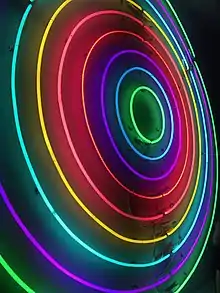
Colorful rings of neon nod to the ancient concept of the universe as a set of concentric planetary orbits. The effect is both esoteric and industrial, morphic and distinctly concrete.
Exhibitions
Selected Solo Exhibitions
- 2020: Opera Gallery, London, England
- 2018: Rain Paintings, There-There Gallery, Los Angeles, CA
- 2018: Portals, Melissa Morgan Fine Art, Palm Desert CA
- 2017: Portals, There-There Gallery, Los Angeles, CA
- 2017: Shields, Fort Gansevoort, New York, NY
- 2016: Maloney Fine Art, Los Angeles, CA
- 2014: Morphic Fields, Walter Storms Galerie, Munich, Germany
- 2012: Consciousness And Portraits Of Sacrifice, Brand New Gallery, Milan, Italy
- 2010: ΚΘ, Patrick Painter Gallery, Santa Monica, CA
- 2007: Visionaire Gallery, New York, NY
- 2007: Milk Gallery presented by Gavlak, New York, NY
- 2007: Gavlak, West Palm Beach, FL
- 2006: Kantor/Feuer Window, New York, NY
- 2005: Holasek Wier Gallery, New York, NY[16]
- 1999: Four, Four, Four Apex Art, New York, NY
Selected Group Exhibitions
- 2019: Crystals In Art: Ancient to Today, Crystal Bridges Museum of American Art, Bentonville, AR
- 2018: Art Aspen, Aspen, Colorado with Melissa Morgan Fine Art
- 2014: Art International Istanbul, Istanbul, Turkey with Louise Alexander Gallery
- 2011: The Armory Show, New York, NY
- 2011: The shortest distance between 2 points is often intolerable, Brand New Gallery, Milan, Italy
- 2011: “Pieces of Heaven” Auction, The Art of Elysium, Los Angeles, CA
- 2010: Art Basel 41, Basel, Switzerland
- 2010: The Armory Show, New York, NY
- 2010: Angel Art Auction Presented by CAA, Los Angeles, CA
- 2009: Blue, Blue, Kim Light / LightBox, Los Angeles, CA
- 2008: Getting Out Our Dreams, Otero Plassart, Los Angeles, CA
- 2007: Some Kind of Portrait, Mark Selwyn, Los Angeles, CA
- 2007: The Armory Show, New York, CA
- 2007: Art Basel, Miami, FL
- 2006: The Monty Hall Problem, curated by Slater Bradley, Blum and Poe, Los Angeles, CA
- 2006: Flaming June VI, curated by Sarah Gavlak, Spanierman Modern, New York, NY
- 2006: Color Theory and Practice, Briggs Robinson Gallery, New York, NY
- 2006: Twenty-Five Bold Moves, curated by Simon Watson and Craig Hensala Of Scenic, House of Campari, New York, NY
- 2002: Superimposition, curated by David Hunt, Caren Golden Fine Art, New York, NY
- 2000: The New Museum, curated by Stefano Basilico, New York, NY
- 1999: Room With A View, Sixth @ Prince Gallery, New York, NY
- 1999: Road Show, DFN Gallery, New York, NY
- 1999: Machine Gun Etiquette, Spencer Brownstone Gallery, New York, NY
- 1999: Foul Play, Thread Waxing Space, New York, NY
Publications
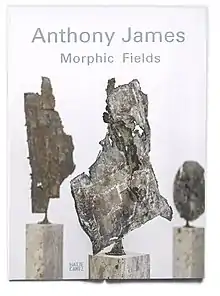
Morphic Fields Book, 2014
Morphic Fields is the title of a series of twenty-one amorphous bronze sculptures with limestone bases— works created from cardboard boxes dipped in and shaped with wax and subsequently cast in bronze. This first monograph on Anthony James includes a number of offbeat essays on the artist’s work. Fashion and art critic Glenn O’Brien provided sharp-witted insights, and writer Christian Kracht added his typically sardonic commentary. An interview with controversial biologist Rupert Sheldrake was a highly fitting contribution; his theory of morphic fields inspired the artist’s work and the title of this publication. Other text contributions include a piece by: Matthias Mühling. The book was printed in Germany and published by Hatje Cantz Verlag.
References
- "Aesthetica Magazine - Impact on the Market". Aesthetica Magazine. Retrieved 2020-04-09.
- "anthony james on 'the colossally vast and the infinitesimally small'". designboom | architecture & design magazine. 2020-04-05. Retrieved 2020-04-09.
- "Anthony James Sacrifices His Ferrari 355 Spider for Artwork". Palm Springs Life. 2019-07-27. Retrieved 2020-04-10.
- Michael Slenske, 2017, “Spiritual Gangster”, Cultured Magazine, pp. 194-199.
- Glenn O’Brien, “Casual Magic: The Art of Anthony James”, Morphic Fields, Munich: Hatje Cantz Verlag, 2014, pp. 58-71
- "anthony james on 'the colossally vast and the infinitesimally small'". designboom | architecture & design magazine. 2020-04-05. Retrieved 2020-04-09.
- Glenn O’Brien, “Casual Magic: The Art of Anthony James”, Morphic Fields, Munich: Hatje Cantz Verlag, 2014, pp. 58-71.
- "Into the Mirrors: Anthony James". Interview Magazine. 2010-09-29. Retrieved 2020-04-10.
- Glenn O’Brien, “Casual Magic: The Art of Anthony James”, Morphic Fields, Munich: Hatje Cantz Verlag, 2014, pp. 58-71.
- Katja Eichinger, “An Interview with Rupert Sheldrake”, Morphic Fields, Munich: Hatje Cantz Verlag, 2014, pp. 52-57.
- Matthias Muhling, “An Interview with Anthony James”, Morphic Fields, Munich: Hatje Cantz Verlag, 2014, pp. 77-89.
- Fort Gansevoort, https://static1.squarespace.com/static/55ee2fc1e4b0c1020ff7e01a/t/591f29c103596e77e94503c7/1495214536115/FG_AnthonyJames_PressRelease_FINAL.pdf, “Anthony James/Fabulism”, 2017.
- Fort Gansevoort, https://static1.squarespace.com/static/55ee2fc1e4b0c1020ff7e01a/t/591f29c103596e77e94503c7/1495214536115/FG_AnthonyJames_PressRelease_FINAL.pdf, “Anthony James/Fabulism”, 2017.
- Fort Gansevoort, https://static1.squarespace.com/static/55ee2fc1e4b0c1020ff7e01a/t/591f29c103596e77e94503c7/1495214536115/FG_AnthonyJames_PressRelease_FINAL.pdf, “Anthony James/Fabulism”, 2017.
- "exhibitions". there-there. Retrieved 2020-04-03.
- "artnet Magazine - The Return of Anthony James". www.artnet.com. Retrieved 2020-04-03.
External links
- Official Website
- "The Market for Crystals Is Outshining Diamonds in the Covid Era" Hannah Elliott for Bloomberg May 2020
- "Explore This Socially Distanced L.A. Art Project Without Leaving Your Couch" Vogue May 2020
- "Anthony James on Capturing 'The Colossally Vast and The Infinitesimally Small' Through Light" DesignBoom April 2020
- "Impact on the Market" Aesthetica April 2020
- "The Top 5 Offline Art Exhibitions That You Can Now See Online" FAD Magazine April 2020
- "Pictures from a Pandemic: Anthony James" Anthony Haden-Guest for Whitehot Magazine April 2020
- "Artist Anthony James Makes Exhibition of Huge Light Sculptures Available to View Online" Evening Standard March 2020
- "Miami Art Week 2019: Works From Wood" December 2019
- "Magical Thinking at the Park Avenue Armory" New York Magazine, The Cut November 2019
- "Anthony James Builds LED Portals Inviting Viewers into Otherworldly Geometrics" DesignBoom November 2019
- "The Allure of Crystals in Art Across Time" Hyperallergic October 2019
- "Anthony James | Portal Series" Flaunt Magazine August 2019
- "Crystal Clear: David Yurman and Anthony James on Their Illuminating Collaboration" Wallpaper January 2017
- "Riding With Anthony James: The Artist Who Torched His Ferrari" Forbes September 2011
- "Art review: Anthony James" Los Angeles Times November 2010
- "The Return of Anthony James" Charlie Finch for Artnet March 2006
- "New Year, New Star" Charlie Finch for Artnet January 2005
